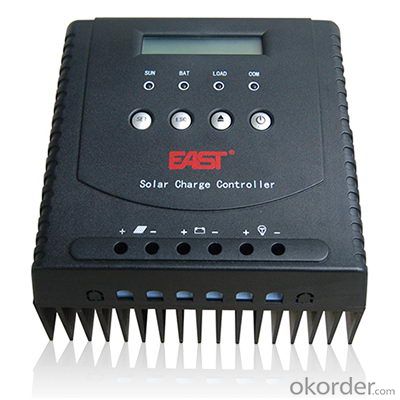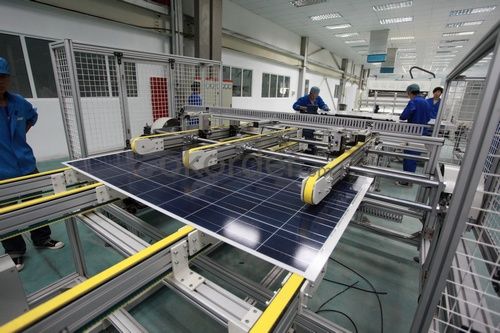Solar Charge Controller LCD 10A-60A Solar Charge Controller LCD 10A-60A
- Loading Port:
- China main port
- Payment Terms:
- TT or LC
- Min Order Qty:
- 1 pc
- Supply Capability:
- 1000 pc/month
OKorder Service Pledge
OKorder Financial Service
You Might Also Like
Solar Charge Controller LCD 10A-60A
This is a highly intelligent charge controller with (MPPT). The optimal and intelligent “MPPT + SOC” charge control is implemented. The power switching components consist of low-loss MOSFET type transistors that have a long operating life and guarantee high performance. The extremely low own consumption makes it especially suitable for solar home systems, solar street lamp system, advertising lighting, traffic management system, and other professional applications etc. With the reverse polarity protection, lightning protection, electronic fuse and automatic detection of faulty battery, the controller is robust, maintenance-free and user-friendly.
● Intelligent operation: the system will automatically start PV charging function without the manual operation.
● High efficiency MPPT function (optional): the system adopt maximum power point tracking technology, even if the battery using in the different condition, this MPPT controller could ensure the Maximum output power from the PV panels, and increase 20-30% electrical power using efficiency from solar panel.
● Reliability: Adopt the Hybrid controller to realize “MPPT+SOC” double intelligent charge control, ensure the product stability and reliability.
● Intelligent charge control: With automatic battery temperature compensation, constant current and constant voltage integrated charge mode, improve the battery's charging efficiency and working life.
● Battery protection: automatically detect the battery working condition, when overdischarge, the system will be shut down automatically, avoid wasting the battery energy.
● High efficiency: Power loop adopts low-loss MOSFET type transistors in series, PWM Soft switching technology is applied to reduce switching loss, Synchronous rectification technology is applied to decrease voltage drop, increase the system's efficiency.
● Intelligent: Illumination recognition auto power on(optional): the system can be set to auto turn on the load when lack of sun, such as fog,storm,night. Auto turn on the load, it is a good assistant of transportation illumination.
● Protection: Overcharge protection/ Over-discharge protection / Battery Reverse Current Protection / Overloading Protection/ Short
● Circuit Protection/ Reverse Polarity Connection Protection/ TVS lightning protection etc.
● LCD Display: to show the working mode of solar battery, seal-lead acid battery and load.
● Well Adaptability (optional): through the man-machine interface, charging current fine adjustment can be settable, suitable for Li-ion Battery, lead-acid battery and other storage system.
● Intelligent communication (optional): RS232 and dry connect
● Temperature compensation (optional): with external battery working temperature detective port, to adjust the charging voltage in time according to the battery working temperature
Model | F2448-10/M | F1224-20/M F2448-20/M | F1224-30/M F2448-30/M | F1224-40/M F2448-40/M | F1224-50/M F2448-50/M | F1224-60/M F2448-60/M |
System Voltage | 12V / 24V ;24V/ 48V | |||||
Rated Charging Current | 10A | 20A | 30A | 40A | 50A | 60A |
Rated Load Current | 10A | 20A | 30A | 40A | 50A | 60A |
PV Panels Configuration (Suggestion)(Imp≤Rated Current) | ≤10A | ≤20A | ≤30A | ≤40A | ≤50A | ≤60A |
Battery Capacity | 38Ah~800Ah | |||||
Max. Efficiency | > 98% | |||||
Static Dissipative | < 0.5%(system rated current) | |||||
Solar Battery Port Input Voltage | 12V:0-24V;24V:0-48V;48V:0-95V | |||||
Rated Battery Voltage | 12V / 24V ; 24V / 48V | |||||
Buck Charge Voltage | 14.6V / 29.2V±1% ; 29.2V/58.4V±1% | |||||
Float Charge Voltage | 14.4V / 28.8V±1% ; 28.8V/57.6V±1% | |||||
Overcharge Protection | 14.7V / 29.4V ±1% ; 29.4V / 58.8V±1% | |||||
Charging Resume Voltage | 13.2V /26.4V±1% ; 26.4V / 52.8V±1% | |||||
Undervoltage Alarm | 11.2V /22.4V±1% ; 22.4V / 44.8V±1% | |||||
Overdischarge Protection | 10.8 V / 21.6 ±0.3V ; 21.6V / 43.2 ±0.4V | |||||
Overdischarge Resume Start Voltage | 13.2 V / 26.4 ±0.3V ; 26.4 V / 52.8 ±0.4V | |||||
discharge Circuit Voltage Drop | < 5 %(System rated voltage) | |||||
Overload, Short-Circuit Protection | 125%(60S) / 150%(10S)/ short-circuit auto shut down; | |||||
PV Reverse Polarity Connection Protection | YES | |||||
Display | LCD + LED | |||||
Alarm Mode | sound(optional)/light alarm | |||||
Control Mode | Switch control / PWM | |||||
Working Temperature | c-20℃ ~ +45℃ | |||||
Relative Humidity | 0-95%(noncondensing) | |||||
Storage Temperature | -25℃ ~ +85℃ | |||||
Altitude | 1000m with rated power (increase 100m, reduce power 1%) Max.4000m | |||||
Storage Humidity | ≤85% | |||||
Installation Method | hanging vertical installation | |||||
Packing Dimension WxDxH(mm) | 164×168×55 | 164*168*100 | ||||
Weight(kg) | 0.85 | 2.05 | ||||
Packing Weight(kg) | 1.05 | 2.25 | ||||
Package | 8pcs/carton | |||||
· Q. What is an UPS and What it is for ?
An uninterruptible power supply (UPS) is a device that allows your computer or telephone switch or critical equipement to keep running for at least a short time or longer time when the primary power source is lost. It also provides protection from power surges, spikes, brownouts, interference and other unwanted problems on the supported equipment.
· Q. How long the UPS to run when power goes?
This can take 3 paths.
1.You can pick a UPS that is rated for pretty much the full VA you need so it will be running at 100% of capability and will thus last 'n' minutes.
2.You can pick a UPS that is rated at a much higher VA value than you really need so, for example, is running at 50% of capability and will thus last for longer than the UPS from option 1.
3.You can use extra external battery packs to run for longer. If charging capability allows, the more and the bigger batteries you take with, the longer time UPS runs.
or using a generator after about 6 hours, it will be more cost-effective, with a short runtime UPS to bridge the generator start-up gap.




- Q:Can a solar inverter be used with a solar-powered security camera system?
- Yes, a solar inverter can be used with a solar-powered security camera system. A solar inverter is responsible for converting the direct current (DC) produced by solar panels into alternating current (AC) that can be used to power electrical devices, including security cameras. By connecting the solar panels to a solar inverter, the generated solar energy can be efficiently utilized to power the security camera system.
- Q:What is the role of a solar inverter in a solar-powered desalination system?
- The role of a solar inverter in a solar-powered desalination system is to convert the direct current (DC) generated by the solar panels into alternating current (AC) that can be used to power the desalination equipment. It ensures the efficient utilization of solar energy by transforming it into a usable form for the desalination process.
- Q:Can a solar inverter be connected to a backup battery system?
- Yes, a solar inverter can be connected to a backup battery system. This allows the solar energy generated during the day to be stored in the backup batteries and used during times when there is no sunlight or during power outages.
- Q:What is the role of a communication interface in a solar inverter?
- The role of a communication interface in a solar inverter is to facilitate the exchange of information and data between the solar inverter and other devices or systems. It allows for monitoring and control of the inverter's performance, as well as integration with other renewable energy systems or smart grid technologies. The communication interface enables remote access, diagnostics, and troubleshooting, enabling efficient operation and maintenance of the solar inverter.
- Q:What are the key factors affecting the cost of a solar inverter?
- The key factors affecting the cost of a solar inverter include its power capacity, efficiency, technology type, brand reputation, warranty, additional features, and installation requirements.
- Q:Can a solar inverter be used for three-phase power systems?
- Yes, a solar inverter can be used for three-phase power systems. There are specific three-phase solar inverters available in the market that are designed to convert DC power from solar panels into AC power for three-phase electrical grids. These inverters are capable of synchronizing with the grid and distributing power across all three phases efficiently.
- Q:What is the lifespan of the warranty on a solar inverter?
- The lifespan of a warranty on a solar inverter can vary depending on the manufacturer and the specific model. However, most warranties typically range from 5 to 10 years, with some higher-end inverters offering warranties up to 25 years. It is important to carefully review the warranty terms and conditions provided by the manufacturer to understand the coverage and duration of the warranty.
- Q:How does a solar inverter handle ground fault protection?
- A solar inverter handles ground fault protection by continuously monitoring the electrical currents flowing between the solar panels and the grid. If it detects any abnormal current leakage to the ground, it quickly shuts down the system to prevent any potential electrical hazards or damage. This ensures the safety of both the equipment and personnel working with the solar installation.
- Q:How does a solar inverter handle reverse power flow?
- A solar inverter handles reverse power flow by automatically detecting the excess power generated by the solar panels and diverting it to the utility grid. This process, known as anti-islanding, ensures a safe and efficient operation of the solar system by preventing overloading and potential damage to the inverter.
- Q:How do you calculate the maximum power point voltage for a solar inverter?
- To calculate the maximum power point voltage for a solar inverter, you need to determine the voltage at which the solar panels generate the maximum power output. This is done by varying the load resistance and measuring the corresponding power output. The maximum power point voltage is the voltage at which the power output is highest.
1. Manufacturer Overview |
|
|---|---|
| Location | |
| Year Established | |
| Annual Output Value | |
| Main Markets | |
| Company Certifications | |
2. Manufacturer Certificates |
|
|---|---|
| a) Certification Name | |
| Range | |
| Reference | |
| Validity Period | |
3. Manufacturer Capability |
|
|---|---|
| a)Trade Capacity | |
| Nearest Port | |
| Export Percentage | |
| No.of Employees in Trade Department | |
| Language Spoken: | |
| b)Factory Information | |
| Factory Size: | |
| No. of Production Lines | |
| Contract Manufacturing | |
| Product Price Range | |
Send your message to us
Solar Charge Controller LCD 10A-60A Solar Charge Controller LCD 10A-60A
- Loading Port:
- China main port
- Payment Terms:
- TT or LC
- Min Order Qty:
- 1 pc
- Supply Capability:
- 1000 pc/month
OKorder Service Pledge
OKorder Financial Service
Similar products
New products
Hot products
Hot Searches
Related keywords

































